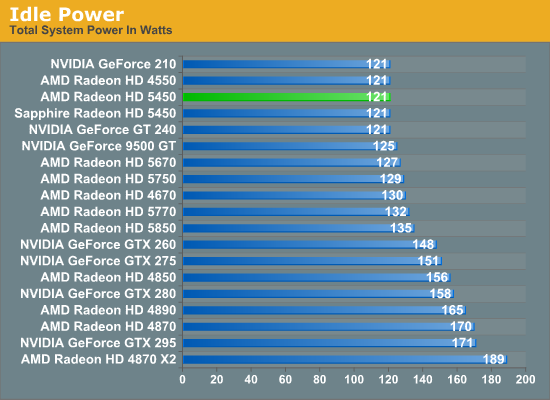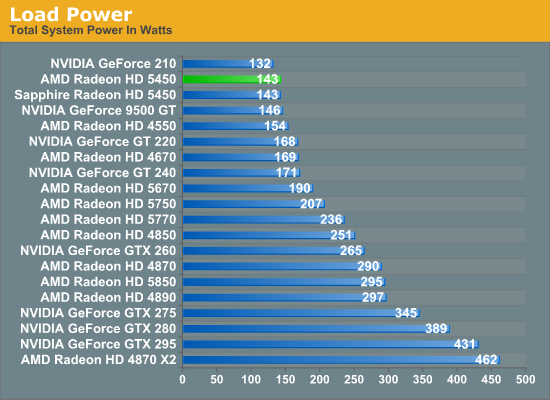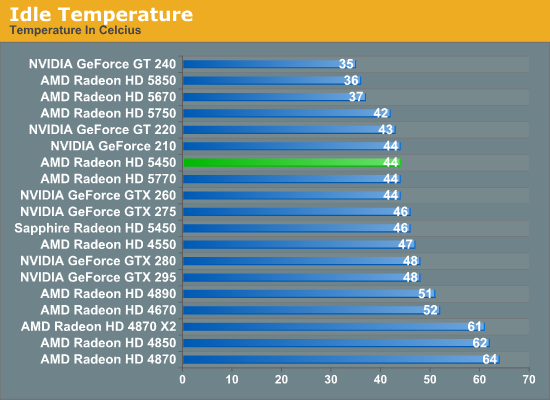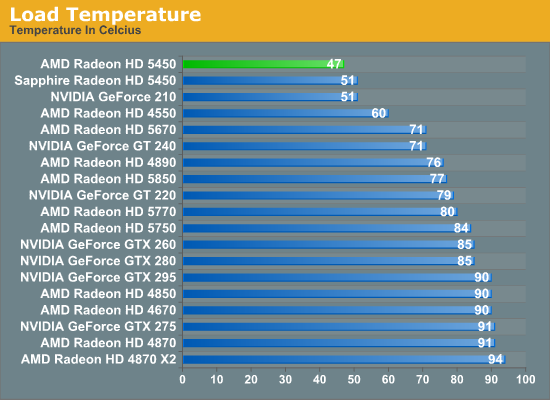AMD’s Radeon HD 5450: The Next Step In HTPC Video Cards
by Ryan Smith on February 4, 2010 12:00 AM EST- Posted in
- GPUs
Power & Temperatures
While entry-level video cards may not top the performance charts, their low transistor count and low power usage means that they do very well on our power and temperature charts. And by being passively cooled, they are winners by default for noise, as they don’t generate any noise to measure.


On paper these cards differ by around a few watts when it comes to idle power, but by the time you put them in our i7 test rig, those few watts melt away. The Radeon 5450, the Radeon 4550, and the GeForce 210 all idle at 121W on our test rig, tying with the GeForce GT 240 for the lowest idle power usage we’ve measured.
Under load this changes some. The 5450 offers the second-lowest load power usage that we’ve measured, coming in below things like the GT 220 and the 4550. It doesn’t quite best the GeForce 210 however, which we believe to be a combination of the 210’s smaller-yet GPU and differences to how NVIDIA and AMD go about throttling their cards when we’re running FurMark.
At any rate, the 5450 does particularly well against other AMD cards, not only beating the 4000-series, but coming in under the 5670 by a hefty 47W. The 5670 may be the better HTPC card from a deinterlacing standpoint right now, but you pay for it with power.


We should note that for our load temperature testing, we use a closed case with all of the fans active on our Thermaltake Spedo case. So the results here are from plenty of airflow being sent towards the first PCIe x16 slot. Since we’re looking at passive cards today, they’re much more affected by this than actively cooled cards are. In a case with little to no airflow, these passive cards would definitely get hotter.
For load temperatures, the 5450 is the coolest video card we have ever tested, taking the title by 4C over its nearest competitor, the GeForce 210. This is thanks in a large part to the use of a double-wide heatsink for better heat dissipation, and of course the low power consumption of the 5450 in the first place. This also gives us a chance to quantify the differences between the double-wide heatsink on the reference card and the single-wide heatsink on the Sapphire 5450; the smaller Sapphire heatsink is only 4C worse at 51C. The double-wide heatsink in this case looks to be overkill.
At idle things change some. Our coolest cards are the actively cooled cards, which have their own fans to keep them cool. The passively cooled cards on the other hand build up some additional heat, coming in at the mid-40s, similar to several of our mid-range cards.










77 Comments
View All Comments
Lifted - Thursday, February 4, 2010 - link
The first graph on each of the benchmark pages lists a 5670, the second graph lists a 4670. Typo or are you actually using different cards?Ryan Smith - Thursday, February 4, 2010 - link
It's not a typo. We never ran the 5670 at 1024x768, there was no reason to. It's more than fast enough for at least 1280.The 4670 data is from the GT 240 review, which we used 1024 on (because GT 240 couldn't cut the mustard above 1024 at times).
8steve8 - Thursday, February 4, 2010 - link
should have had the clarkdale igp in there for good measure, if you aren't gaming I'd guess that igp would be the way to goMrSpadge - Thursday, February 4, 2010 - link
Would have been interesting to compare idle power consumption: Clarkie + IGP vs. Clarkie + 5450.Ryan Smith - Thursday, February 4, 2010 - link
Testing a Clarkie requires switching out our test rig, so the results wouldn't be directly comparable since it means switching out everything including the processor. Plus Anand we only have a couple of Clarkies, which are currently in use for other projects.At this point Clarkie (and any other IGP) is still less than half as fast as 5450.
strikeback03 - Thursday, February 4, 2010 - link
That brings up the point though that with a card this low on the totem pole it might be nice to include a benchmark or two of it paired with similarly low-priced hardware. I understand the reason for generally using the same testbed, but when it is already borderline playable it would be nice to know that it won't get any slower when actually paired with a cheap processor and motherboard.Ryan Smith - Thursday, February 4, 2010 - link
Testing a Clarkie requires switching out our test rig, so the results wouldn't be directly comparable since it means switching out everything including the processor.At this point Clarkie (and any other IGP) is still less than half as fast as 5450.
kevinqian - Thursday, February 4, 2010 - link
Hey Ryan, I'm glad you are the first reviewer to utilize Blaubart's very helpful deinterlacing benchmark. I would just like to note that with ATI, it seems memory bandwidth plays a big part in deinterlacing method as well. For example, the HD 4650 DDR2 can only perform MA deinterlacing, even tho it has the same shaders as the (VA capable) 4670. The only bottleneck there seems to be the DDR2 memory bandwidth. On the other hand, with the HD 4550, though it has DDR3, it is limited to 64bit memory interface, so that seems to be a limiting factor.I have an old HD 2600Pro DDR2 AGP. When I OC the memory from 800mhz stock to 1000mhz, VA gets activated by CCC and confirmed in Cheese slices.
Nvidia's deinterlacing algorithm seem to be less memory intensive as even the GT220 with DDR2 is able to perform VA-like deinterlacing.
Ryan Smith - Thursday, February 4, 2010 - link
Yeah, I've seen the bandwidth idea thrown around. Unfortunately I don't have any additional suitable low-end cards for testing it.ET - Thursday, February 4, 2010 - link
I think I remember reading that the interpolation of input values in the pixel shader was moved from fixed function units to being done by the shaders.